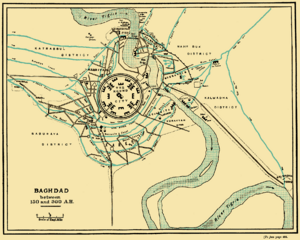Round city of Baghdad facts for kids
Quick facts for kids
The City of Peace / Al-Mansur City
|
|
|---|---|

Baghdad under the early Abbasid caliphs, with the Round City in the middle
|
The Round City of Baghdad (also called Al-Mansur City or the City of Peace) was an amazing ancient capital city in Baghdad, Iraq. It was built a very long time ago, between the years 762 and 767 CE. This special city was designed to be the center of a powerful empire. Today, only a few small parts of the ancient city of Al-Mansur remain.
Contents
Building a New Capital
The Round City was built by the second Abbasid Caliph, Al-Mansur. A caliph was like a powerful ruler or king of the Islamic empire. Caliph Al-Mansur wanted a new capital city for his growing empire. He chose a spot on the west bank of the Tigris River. This location was perfect for trade and defense.
Why a Round Shape?
The city's most unique feature was its perfect round shape. This design was very unusual for cities at that time. Some historians believe the round shape showed the caliph's power. It also made the city easier to defend from invaders. The design was inspired by older Persian cities.
How the City Was Built
Building the Round City was a huge project. Thousands of workers and engineers helped construct it. They used bricks, clay, and other materials from the area. The city was finished in just a few years. It was a marvel of engineering for its time.
Inside the Round City
The Round City had two large circular walls. These walls protected the city and its people. Between the walls were homes and shops. Four main gates led into the city. Each gate pointed towards a different part of the empire.
The Center of Power
Right in the middle of the city was the caliph's palace. This grand building was called the "Golden Gate Palace." Next to the palace was the main mosque, where people went to pray. These central buildings showed that the caliph and religion were at the heart of the city.
Life in the City of Peace
The Round City quickly became a busy and important place. It was a center for learning, trade, and culture. Scholars, artists, and merchants came from all over the world. This period is often called the "Golden Age of Islam." People studied science, math, medicine, and philosophy here.
What Happened to the Round City?
Over time, Baghdad grew much larger than just the Round City. New neighborhoods and palaces were built outside its walls. The original round city eventually lost its importance. It was damaged by floods and conflicts over many centuries.
Today, almost nothing of the original Round City can be seen. Modern Baghdad has been built over it. However, its memory lives on as a symbol of a powerful empire and a time of great knowledge.
Images for kids
-
Map of the Round City on the flag of the Baghdad Governorate
See also
 In Spanish: Ciudad redonda de Bagdad para niños
In Spanish: Ciudad redonda de Bagdad para niños



